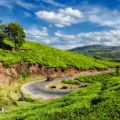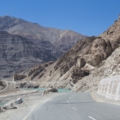Festival in Nepal: Teej - when women look red is written by Tania Karpatschoff
Teej festival in Nepal - a great experience
When it's monsoon time in Nepal, it means not only that the sky opens its floodgates, but also a lot of colorful festivals. And of all the festivals, Teej is perhaps the largest.
A festival based on ancient tradition and mythology that is celebrated to this day by women all over Nepal. Participating in Teej is like swimming in an overwhelmed sea of red. Like stepping into a world resembling the famous "Eastern Bazaar" described in tales such as 'Marco Polo's Travels' and 'Ali Baba and the Forty Robbers'.
Find your flight ticket to Nepal here
Women in red as far as the eye can see
Together with more than 100.000 Nepalese women, I and a group of Danish women from the travel agency Viktor's Grandmother were taken to the Pashupatinath Temple in Nepal's capital Kathmandu. I have been able to read to myself that it is large and that there are thousands of women, but Teej is bigger and wilder than I in my imagination had ever been able to imagine. There are women of all ages and sizes.
It's an insane bombardment of all one's senses, and there are colors in all shades, but with red as the primary color. There is a sweet scent of incense that tickles my nostrils. A few individual goats have also strayed into the middle of the festivity. There are women as far as the eye can see. Everyone is patiently waiting to enter the temple, many have been waiting here for hours.
It's nothing short of a giant women's party. It is quite impossible not to be struck by the deep sense of sisterly solidarity and to be infected by the cordiality and joy these women radiate with their song and dance.
On this occasion, we have sewn red clothes, and it arouses great enthusiasm. At times, the interest is overwhelming. We are constantly stopped by women who want to compliment us on our red clothes and want to have pictures taken with us.

A long party
The Teej Festival in Nepal is a three-day celebration that combines lavish celebrations with religious rituals and rigid fasting. Traditionally, Teej's ritual is mandatory for all Hindu married women and girls who have reached puberty. Exception is made for those who are sick or physically unfit. But it is also a day for women to be together to sing and dance.
On the first day of Teej, the married women are invited to their childhood home, where they are celebrated with their sister, friends and close female family members with good food, song and dance.
The second day is Teej's most important day. The day is dedicated to fasting and prayers. Some women keep strict fast without eating and drinking as much as a single drop of water, while others drink fluids and eat fruit. Common is that the women through the 24 hour long religious fast pray for marital bliss, the welfare of their spouse and children and the cleansing of their own body and soul.
Women go with female family members to the local Shiva temple and pray for a 'Lingam' - a phallus symbol of the Lord - adorned with flowers, candies and coins. Beautifully decorated figures - called idols - of the gods Shiva and Parvati are offered fruit and flowers to seek blessings from the divine spirits.

Strictly forbidden for men to Teej festival in Nepal
In Kathmandu, the Pashupatinath Temple, located on the banks of the sacred Bagmati River, is the favorite place for Nepalese women to worship Lord Shiva. According to the Pashupati Area Development Trust, up to 500.000 women come to Pashupatinath under Teej.
The temple is strictly forbidden to ordinary men. Only a few policemen, overseers, and Samaritans most graciously gain access to the temple area under Teej.
When the women have finished their worship ritual Puja, they gather in large groups in the temple square and dance and sing the very special Teej songs until the sun has set.
On the third and final day of the Teej Festival in Nepal, the seven holy men are worshiped in the Hindu panteon, by the women taking holy baths in red mud taken from the roots of the sacred bush Datiwan to ensure that all the sins committed in the past will be cleansed. Only then can the fast be broken.
Travel Deals: Experience India's Golden Triangle

An experience that sits in the body
Since ancient times, the Teej Festival in Nepal has been celebrated among Nepalese women. Although most of the modern women no longer adhere to the very strict fast, they still celebrate Teej as a celebration that symbolizes sisterly solidarity, strengthening of relationships and above all as a symbolic surrender of cultural values.
But more and more people are also criticizing that Teej is becoming more and more superficial and materialistic, and that among some groups there seems to be a marked shift from puja, regular and ritual baths to the purchase of new saris and to large Teej parties with lots of delicacies. and delicacies.
Either way, Teej is an experience that sits in the body and on the retina very long after leaving the temple and the 100.000 sages of red-clad women
See much more about traveling in Nepal here

















































Add comment